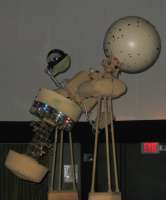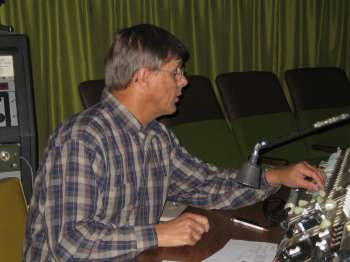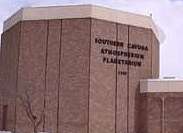- By Dan Veaner
- Around Town
 Print
Print  You don't typically expect to find a planetarium unless you are in a science museum in a mid to big city. So it is surprising to find a planetarium in Poplar Ridge. Located on the Southern Cayuga Central Schools campus the facility, along with an observatory, the planetarium presents a unique opportunity for students and the public to study astronomy. For the past four years John Rusho has been running the facility and presenting programs on astronomy to Southern Cayuga students as well as free programs open to the public.
You don't typically expect to find a planetarium unless you are in a science museum in a mid to big city. So it is surprising to find a planetarium in Poplar Ridge. Located on the Southern Cayuga Central Schools campus the facility, along with an observatory, the planetarium presents a unique opportunity for students and the public to study astronomy. For the past four years John Rusho has been running the facility and presenting programs on astronomy to Southern Cayuga students as well as free programs open to the public.Rusho has been interested in astronomy since he was a kid. "My uncle got me interested in astronomy," he recalls. "He wore a pair of field glasses. He showed me how they would show you some of the bigger craters on the moon. Somehow I was always interested." After graduating from college Rusho's interest in astronomy didn't diminish. "The first thing I bought was a car, because I needed to get to my job, and the second thing I got was a telescope," he says. "That was in 1967, by coincidence the same year this planetarium was built."
Currently the facility is being run on a NASA grant that Rusho applied for two years ago. But with rising costs the school system eliminated several positions and Rushos is one of them. His position will be gone at the end of June. But Business Administrator Charles Mellor says the district wants to keep the facility open. "We are waiting for approval of a NASA grant to fund two individuals to manage, program and operate the Planetarium and Observatory," he says.
Programs that are continuing at least through June include presentations for all the grade levels from K-12. "I'm here on Mondays, when the school's in session," Rusho says. He tailors the programs to each grade level, supplementing the science teachers' curricular needs. "I also come down once a month on Friday nights to do the public nights. Plus occasional special events. Last Wednesday I was here for Leadership Cayuga. I've done that several times, it's a bus tour." There is also a TC3 program that offers college credit, and a newsletter that Rusho has been editing.
The equipment is old, and parts of the control board no longer function. But Rusho has learned to coax it to show the constellations he wants. The panel has switches and knobs that control the central projector as well as other projectors used to show details of planets and stars and related content. While modern planetariums let the operator dial in a date and locations, this one is set manually. Rusho cycles it through the years until the stars are aligned as he needs them for a particular presentation. He says it is possible to skip, but that requires creating presets ahead of time.

Rusho cycles the star projector through the years
He uses presets for special programs such as the Christmas Star presentation, where takes viewers from the present to the 7th century sky. "The Earth's axis wobbles over a 26 thousand year period," he explains, "so the North star wasn't always the North star so to speak, and that is a very effective demonstration." He says demonstrating scientific phenomena in this way is much more effective than trying to describe them in a classroom.
 Rusho's involvement in astronomy isn't limited to the planetarium. He teaches part time at Oswego State and Onondaga Community College. He's been active in the Syracuse Astronomical Society since 1976. "At one time or another I've been president, vice president, instrumentation chairman and summer seminar chairman," he says. Since he got that first telescope he's collected about a dozen more, up to 14 inches in diameter. "I like working on and building telescopes that I've built from scratch," he says.
Rusho's involvement in astronomy isn't limited to the planetarium. He teaches part time at Oswego State and Onondaga Community College. He's been active in the Syracuse Astronomical Society since 1976. "At one time or another I've been president, vice president, instrumentation chairman and summer seminar chairman," he says. Since he got that first telescope he's collected about a dozen more, up to 14 inches in diameter. "I like working on and building telescopes that I've built from scratch," he says.For the future, the school district plans to continue offering programs within the schools and for the public. "Focus will continue to be on public school groups, private school groups as well as night activities for star gazing for the general public," Mellor says. "A newsletter will be developed informing everyone of the facilities available. College groups will also be encouraged to attend. Our classroom teachers will continue to use the facilities as part of their science curriculum."
So for at least one more month Rusho will continue the existing programs in the planetarium, sharing his love for the stars with kids that he has had since he was a kid himself.
----
v2i20



